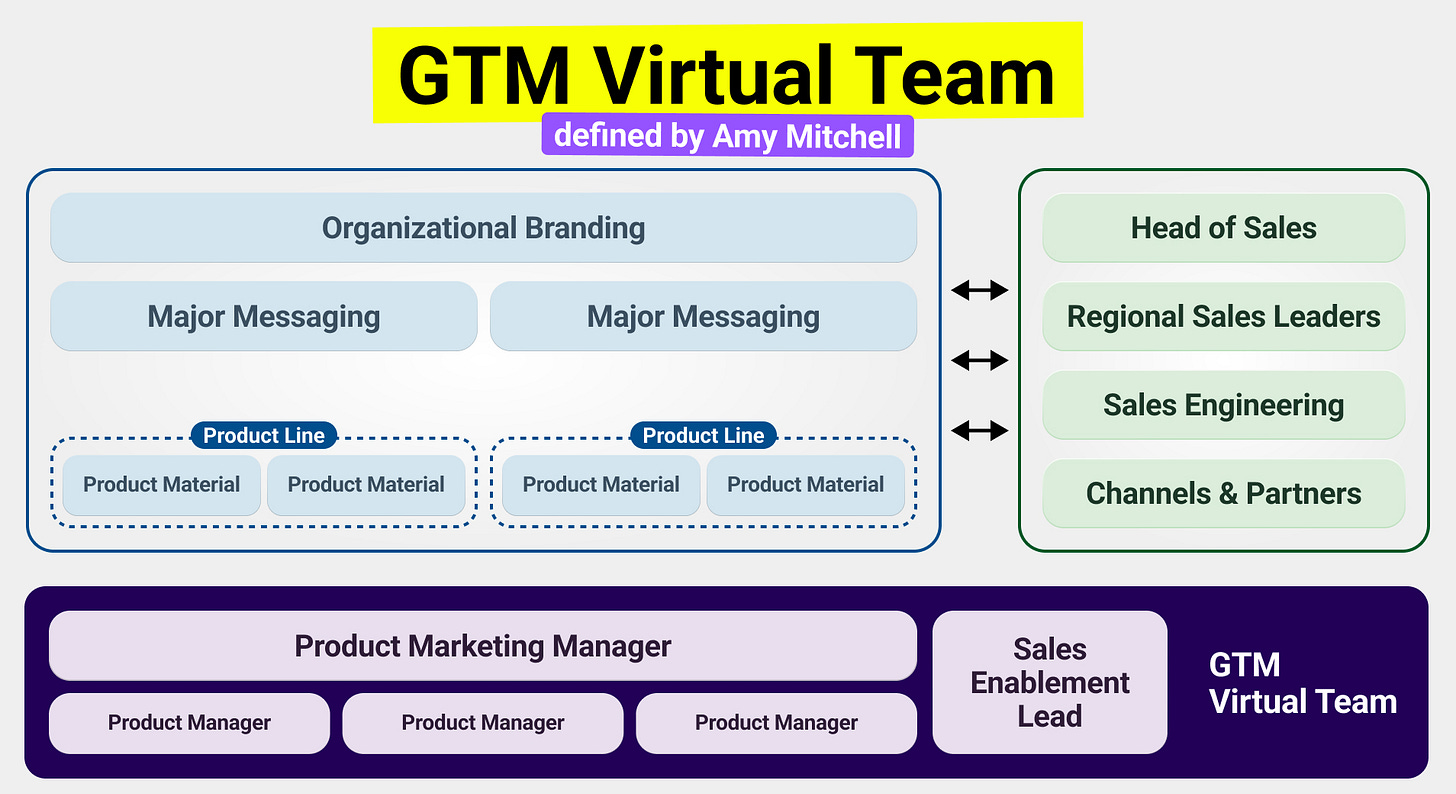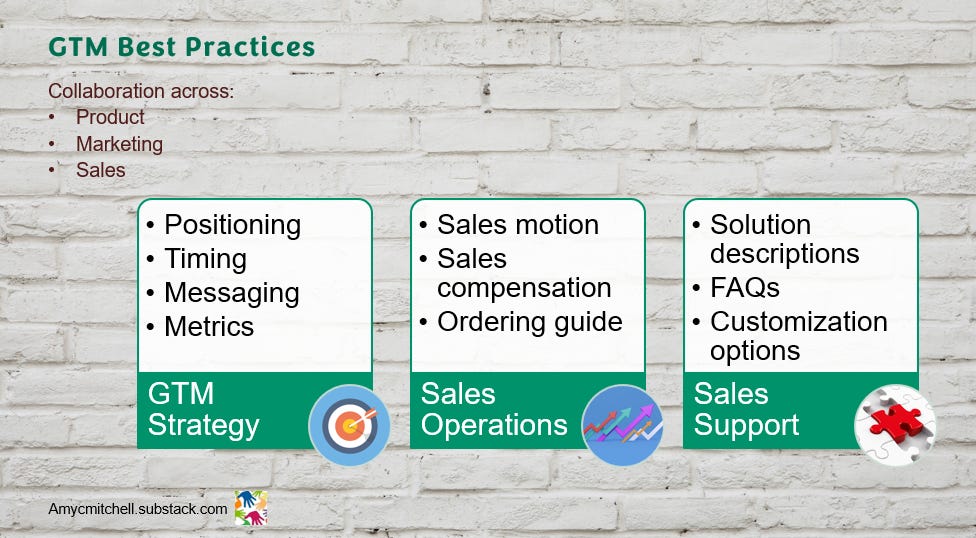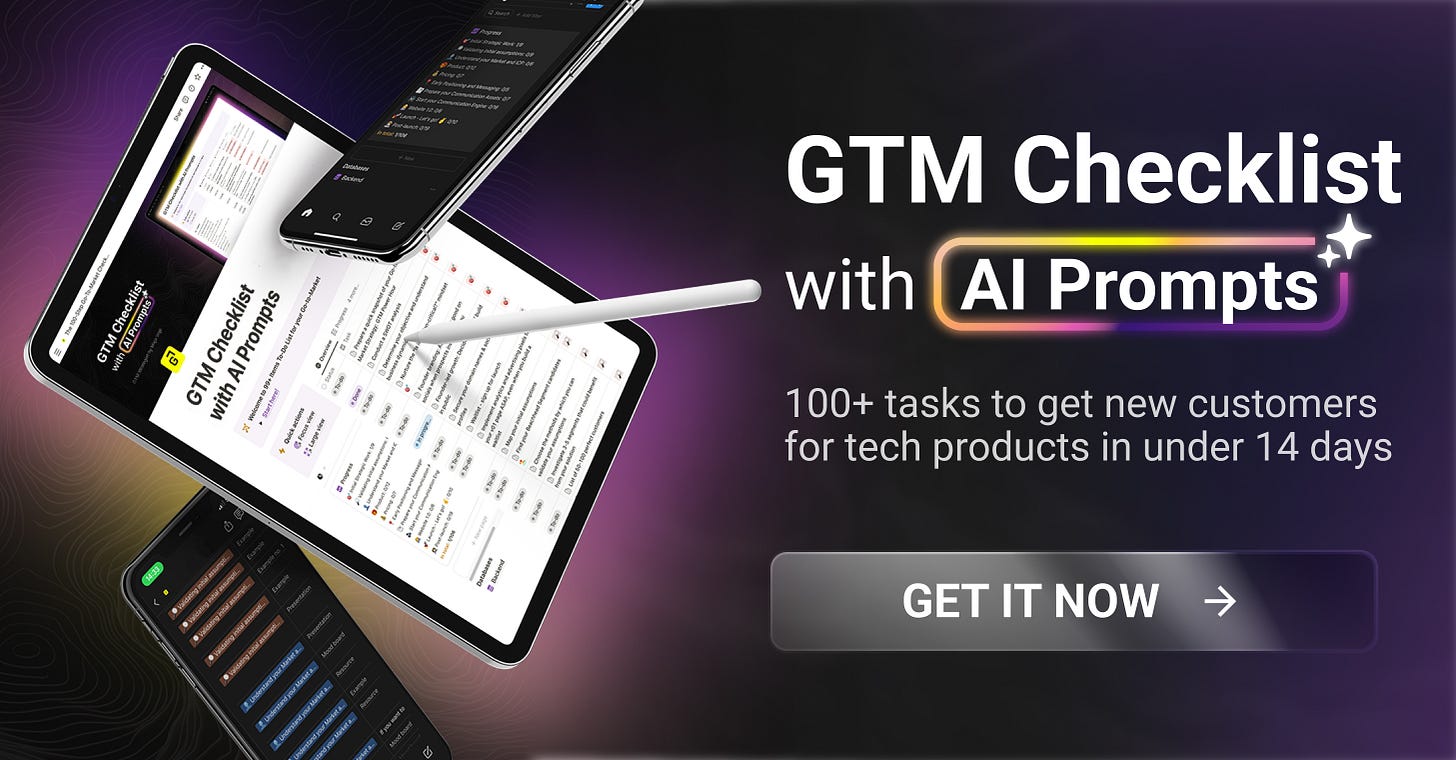Enterprise GTM Unpacked
Collaboration, Strategy, and Sales Enablement
Dear GTM Strategist,
An enterprise cannot “just move fast and break things.” I am often asked how go-to-market strategies and decisions look at large and complex organizations.
To hear this firsthand, I invited Amy Mitchell, Principal Product Manager at Dell and author of the "Product Management IRL" Substack, to share her invaluable go-to-market insights. With over 30 years of experience at leading enterprises such as Cisco, Hewlett Packard, Alcatel (Nokia), and Zerto, we are in great hands to navigate the complexities and best practices of enterprise GTM.
In this Substack, you will learn:
The specifics of doing GTM in the enterprise environment ($1B+ yearly revenue)
Best practices on how to navigate the enterprise specifics as a GTM leader with a strong emphasis on collaboration, strategy, and sales enablement
What everybody should know about sales enablement and why it makes such a massive difference
3 case studies for PMs and PMMs in large enterprises
And I had to ask: “How can a small business have a fair chance to shake hands with an enterprise client even in the earlier GTM stages”?
Do you handle thousands of support interactions every month?
Tidio is opening access to their AI customer support agent for the GTM Strategist subscribers. You can now automate up to 64% of your emails and live chats with AI—completely free, with no commitment for the first 3 months. Tidio’s team will help you set up Lyro, their AI agent, and include up to 10,000 conversations during this trial. You can add it to your existing support platform or use Tidio’s complete suite.
This post is sponsored by Tidio. Tidio’s AI agent, Lyro, guarantees a 50+% resolution rate with hassle-free setup and no strings attached.
Installed by over 300,000 businesses, Tidio is a complete customer service platform that consolidates your support requests from live chat, email, and social media into one dashboard.
Now, let’s hear it from Amy Mitchell:
Picture this: you're leading a global enterprise's go-to-market strategy for a new feature. In the smaller organizations you've worked with, you owned the end-to-end GTM process. Decisions were streamlined, and execution moved quickly.
The differences aren't just about scale; it's about navigating a more intricate system of roles, processes, and priorities. To bring the creativity and agility of smaller organizations into the enterprise world, you first need to understand the structure and strategies that global enterprises use in GTM.
However, in a large enterprise, the dynamics are different. Layers of stakeholders, complex approval chains, and diverse regional needs can feel like barriers to your tried-and-true methods.
Why GTM in Enterprises Feels Like a Different World
A large enterprise typically has an annual revenue of $1B+. Besides the high revenue, there are other differences in the enterprise environment:
Large scale: more employees, multiple divisions, broad geographic presence. Leading to complex organizations and sophisticated management structures.
Significant market share: Major product lines that command a significant portion of their market.
Substantial financial resources: investing in research and development, marketing, and expansion.
Brand recognition: high brand recognition and loyalty. Products are widely known and trusted by customers and the market.
Corporate Social Responsibility: priority on initiatives that support environmental sustainability, diversity, and community development.
In this enterprise world, these differences impact the GTM teams significantly:
Regional differences: Country leadership and metrics with dependencies on headquarters
Sales organization: Account management is divided into territories, verticals, and named accounts
Field CTOs and Sales engineering: technical giants providing thought leadership and driving long-term growth
Strategic partnerships: with top-tier consulting firms for expertise and insights to drive growth and competitive advantages
Marketing budgets: allocated to channels, campaigns, business units, and geographic regions. Measured as a percent of revenue evaluated by return on investment
Selling breadth: extensive product catalog with complex sales incentives
Product teams: product managers and product marketing managers for every product
This means GTM teams are dealing with multiple organizational layers and multiple cross-functional teams.
Collaboration Structures for GTM in Large Enterprises
Due to the scale of large enterprises, there is a hierarchy of GTM. At the bottom are the products that the organization sells. Next comes the product lines and major messaging to the market. At the top are the organizational and branding positions.
Adjacent to the organizational hierarchy of outbound marketing is the sales organization. Sales is a key user of the GTM materials. However, sales are not organized like marketing. Sales are organized to match the key customer segments that the organization is targeting.
Marketing initiatives in large enterprises follow two major categories:
Corporate marketing goals supporting brand feelings and public perception of the enterprise
Technology initiatives aimed at launches or targeted growth of a customer segment
A fully staffed senior team of branding and marketing specialists generally handle corporate marketing initiatives. On the other hand, the technology initiatives come up through the product teams distributed in the business units in the organization.
In both cases, virtual teams form around the initiative to drive it to closure and measure the ROI of the investment. The desired outcome of the initiatives is to catch the eye of potential customers which leads to future sales.
While corporate marketing is fairly straightforward and handled by a dedicated team, how does a large enterprise control its technology and product initiatives? Budgets and policies are the way to do this.
Budgets are top-down and cover marketing and product funding. Annual budgeting is driven by current and future sales.
Policies cover any outbound communication. Consistency of messaging and partnering is mandatory as well as perceptions in the global community.
GTM initiatives in large enterprises are often driven by self-managed virtual teams, bringing together key stakeholders from different functions. These teams typically consist of:
Product Managers (PMs): Focus on product launches, ensuring their products are successfully developed and introduced to the market.
Product Marketing Managers (PMMs): Oversee corporate marketing strategies, budgets, and positioning to align products with broader business objectives.
Sales Enablement Leads: Bridge the gap between product and sales, equipping sales teams with the resources, training, and insights needed to close deals effectively.
Each role plays a crucial part in the success of enterprise GTM execution, ensuring alignment between product development, marketing strategy, and sales effectiveness.
How do these GTM virtual teams operate successfully in a large enterprise?
Large enterprises have sales enablement leads, who are the link between product, marketing, and sales and are crucial for winning go-to-market efforts. Sales enablement leads are part of the marketing organization or they are part of sales leadership. Here is more on sales enablement by Salesforce.
What Sales Enablement Does in Enterprise GTM
The sales enablement team in enterprises is key to connecting product information in a meaningful way to sales. Quota-carrying account teams need thoughtful insights from the sales enablement team to develop opportunities for long-term happy customers.
Timely information on customer segments and competition that is tuned to sales success can free up salespeople to build relationships with potential customers. The sales enablement teams are key to connecting product and marketing material to the sales teams.
Why can't the sales teams adapt product and marketing material to fit their work with prospective customers? While good product documentation and marketing materials are important, these materials rarely link customer problems to solutions that work in their environment. Sales teams need business and technical information for the different audiences they meet.
In B2B, there are users to help and buyers to satisfy before closing a sale. On the typical B2B product sale, the account team needs to show how your product responds to their problem. Some of the audiences that B2B sales teams contact are:
IT users who need to be more responsive
CIOs and IT directors who must deliver cost reductions
End users of the enterprise
Procurement managers who drive contract terms
System architects who need to scale the enterprise resources
Material that shows the problems of these different audiences and links to solutions saves time to build relationships with key people in the potential customer.
What Are the Key Sales Enablement Activities?
Successful sales enablement teams have organized their work and timelines to anticipate the needs of account teams calling on large enterprises. A few key activities that sales enablement teams drive are:
Filling content gaps - connecting product and marketing materials to verticals and regions
Messaging across regions - tailoring content to language and regional practices while keeping consistent messaging
Rapid communication channels - ordering guides, sales pages, targeted training maintained to meet evolving customer needs
Ongoing sales support - a clearinghouse for sales opportunities plus sales decks and frequently asked questions and answers (FAQs)
Successful sales enablement teams have organized regionally to work closely with sales and customers. Additionally, sales enablement is tuned into the product development cycle. They play a key role in anticipating sales needs and keeping the pipeline full of customer opportunities.
Best Practices for GTM in Large Enterprises
The benefit of the virtual team with PMs, PMMs and sales enablement is navigating the organizational layers and cross-functional demands of large organizations. Large enterprises have developed a variety of ways to generate sales depending on their market and product offerings.
Despite the differences from enterprise to enterprise, I’ve found three best practices that successful virtual teams use.
GTM Best Practice 1: Align on GTM strategy early in the product development cycle
Agreeing on the GTM strategy between the virtual team is a game changer for product success.
Often the PM wants prominent communication about their product benefits. While the PMM is focused on supporting the broader messaging and positioning. Sales enablement sets a strategy with these key elements:
Positioning of the product relative to the rest of the products in the organization
Timing of launching and other outbound activities
Messaging that fits in the corporate brand and initiatives
Business metrics that align with organizational business objectives
Frequently, stakeholders are involved in settling strategy debates because there are tradeoffs between positioning and business impacts. For example, when launching new features, a mid-tier product could encroach on a top-tier product market segment.
The GTM strategy sets the budget and plans for the GTM activities leading up to the launch.
GTM Best Practice 2: Optimize Sales Productivity with Sales Operations
The sales operations team is focused on minimizing sales friction. In a large enterprise this team is crucial for:
Handling commerce tools to book orders and recognize revenue
Track the sales pipeline through CRM tools (like Salesforce) to forecasting and sales management
Automation and smooth handoffs through the sales cycle
A good sales operations team keeps sales teams focused on customers!
Execution of the GTM strategy depends on the sales enablement plan. The GTM virtual team develops materials and training to deliver the sales enablement plan.
A key part of the sales enablement plan is processing new customer orders at scale. The kinds of materials the GTM virtual team provides for sales operations are:
Sales motion that is easy to follow from first customer contact through booking the order
Sales compensation that is automatically tied to the products the customer orders
Ordering guidelines that are maintained based on sales feedback
The key deliverables for sales operations are:
A sales training slide deck that covers the sales motion, product overview, and sales compensation
An ordering guide with product use cases, ordering examples and where to go for help
The sales enablement team trains the sales operations team on deal handling ahead of the product launch.
GTM Best Practice 3: World-class sales support in place
Sales teams that solve customers’ problems with their solutions must:
Know every product in their sales targets - depending on the sales organization, each sales team can be handling 100s of products
Know their customers deeply - sales team relationships are important for budgetary insights, growth plans, and access to decision-makers
A winning GTM strategy prioritizes providing sales support information and people across the enterprise to support.
Enterprise-scale deals involve multiple products and services. The sales support teams have a deep understanding of customer use cases and they adapt the marketing materials into solutions for potential customers.
The GTM virtual team develops these key materials:
Solutions for pre-sales support: customer drivers for the solution, competitive options, and product overview
Technical white papers: cost savings calculations, reference architectures, compliance matrices, and solution overviews
FAQs and Proposal responses: details that customers need to spend money on your product such as compliance, support policies, access to the product, licensing, expansions, white papers, and validated designs
Enhancements and customization options: how to handle objections and variable options in the product
The material is updated frequently to cover product updates and new reference architectures.
The GTM virtual team delivers product materials that sales can use to find answers. This is some of the most creative material in the organization!
Conclusion: Mastering Enterprise GTM with Collaboration and Strategy
GTM in a large enterprise requires a structured, multi-layered collaboration of a global business. Success doesn’t come from a single function—it results from product managers, product marketing managers, and sales enablement leads working together to align strategy, messaging, and execution.
By adopting best practices such as early GTM alignment, reduced sales friction from sales operations, and world-class sales support, virtual teams can drive impactful go-to-market initiatives. The key is to leverage cross-functional collaboration and ensure sales teams have the tools they need to win deals.
Whether you’re launching a new feature or driving a major strategic initiative, understanding and mastering these enterprise GTM principles will set you up for success in even the most intricate organizations.
After navigating through the enterprise GTM landscape, I had to ask Amy a question that is probably keeping a lot of us on our tippy toes when reading this valuable article: “How can a startup successfully sell to an enterprise?”
For a startup that enables sales of an enterprise product, the startup needs to work closely with the enterprise sales team to close joint customer deals. In parallel, the startup needs to contact the corresponding product leaders to provide customer feedback on the joint solution.
For example, suppose you are a startup that provides a data protection service for enterprise storage products. One of your sales teams has a customer using your product with a leading enterprise storage vendor. Your sales team begins working with the enterprise sales team. This leads to meeting the enterprise partner team followed by meeting the storage product leadership team.
Why does the big enterprise want to talk to a startup? Two reasons:
The startup can bring new customers to the enterprise - Reason: enterprise sales teams can’t spend time developing a small opportunity.
The startup can bring concentrated insights on customers - Reason: enterprise product leaders have limited time with customers and miss key insights.
For a startup that sells to an enterprise without a joint customer, then the startup needs to join the enterprise’s partnership program. And the startup needs to get the users in the enterprise to try their product. Before attempting to get enterprise users, the startup needs to show there is no security or compliance risk to the enterprise. You can see some examples of partnership programs at Microsoft, AWS, and Dell.
Let’s suppose you have an AI utility that can extract speech-to-text from customer service calls. This utility can save time handling incoming support calls by routing the call to the right expert in the enterprise. You would need to provide a copy of your utility to the enterprise so the enterprise call data is not exposed outside. You also join the enterprise partner program.
Why does the big enterprise want to talk to a startup about a cost-saving utility?
The enterprise leaders are under intense pressure to modernize and find cost savings - a startup has examples of real cost savings
The startup offers a low-risk way to demonstrate costs savings - the startup has covered security and privacy concerns
Wow - just wow.
Where there is a vision, there is a path.
Thanks so much, Amy, for sharing your knowledge and best practices with us. 💜
If you would like to learn more about Product Management in larger organizations, follow Amy Mitchell on LinkedIn and subscribe to her Substack Product Management IRL.
As Amy pointed out, world-class support is one of the best GTM practices. So let me remind you of a special offer for my subscribers to try Tidio’s AI customer support agent, Lyro, completely free for 3 months. This includes up to 10,000 conversations and full implementation support.
Let’s go to (the enterprise) market!
Maja
📘 New to GTM? Learn fundamentals. Get my best-selling GTM Strategist book that helped 9,500+ companies to go to market with confidence - frameworks and online course included.
✅ Need ready-to-use GTM assets and AI prompts? Get the 100-Step GTM Checklist with proven website templates, sales decks, landing pages, outbound sequences, LinkedIn post frameworks, email sequences, and 20+ workshops you can immediately run with your team.
🏅 Are you in charge of GTM and responsible for leading others? Grab the GTM Masterclass (6 hours of training, end-to-end GTM explained on examples, guided workshops) to get your team up and running in no time.
🤝 Want to work together? ⏩ Check out the options and let me know how we can join forces.













Thank you for collaborating on this Maja! The world of enterprise GTM is challenging and rewarding.
Great article. If you ever want the perspective of FinTech/payment products GTM happy to collaborate :)